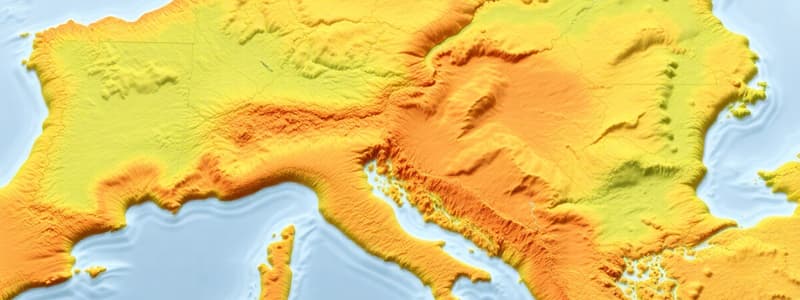Podcast
Questions and Answers
What does the term 'spatial resolution' refer to in the Raster Data Model?
What does the term 'spatial resolution' refer to in the Raster Data Model?
- The total area covered by the raster.
- The version of the Geo-referencing system used.
- The size of each grid cell measured as ground distance. (correct)
- The number of layers in a raster dataset.
Which type of raster is best suited for representing continuous data such as temperature?
Which type of raster is best suited for representing continuous data such as temperature?
- Floating Point Rasters (correct)
- Binary Rasters
- Character Rasters
- Integer Rasters
How are raster cells geo-referenced?
How are raster cells geo-referenced?
- Using the X, Y coordinates of the bottom-right cell.
- According to a global positioning system (GPS).
- By assigning unique IDs to each cell.
- Using the X, Y coordinates of the top-left cell. (correct)
Which of the following statements about attribute storage in raster layers is accurate?
Which of the following statements about attribute storage in raster layers is accurate?
Which statement correctly describes the differences between vector and raster models?
Which statement correctly describes the differences between vector and raster models?
What is the purpose of the header information in a raster data structure?
What is the purpose of the header information in a raster data structure?
Which of the following is NOT a type of raster data?
Which of the following is NOT a type of raster data?
In what order are attributes stored in raster data?
In what order are attributes stored in raster data?
Flashcards
Raster Data Model
Raster Data Model
A way to represent geographic data as a grid of cells, where each cell stores a value for a specific location.
Grid Cells
Grid Cells
Square units that make up a raster grid, each representing a specific location and its associated value.
Spatial Resolution
Spatial Resolution
The size of each cell in a raster, determining the level of detail captured.
Attribute Storage
Attribute Storage
Signup and view all the flashcards
Qualitative Raster
Qualitative Raster
Signup and view all the flashcards
Quantitative Raster
Quantitative Raster
Signup and view all the flashcards
Binary Raster
Binary Raster
Signup and view all the flashcards
Header Information
Header Information
Signup and view all the flashcards
Study Notes
Raster Data Model
- Represents the world as a continuous field, unlike vectors which use discrete objects
- Useful for phenomena that vary continuously (e.g., temperature, elevation, land cover)
Key Features
- Grid-based representation: divides space into square grid cells (or lattice)
- Each cell stores an attribute/value for that location
- Different from vector models that use points, lines, or polygons
- Spatial Resolution: Size of grid cells (measured in ground distance)
- Finer resolutions (smaller cells) capture more detail but require more storage
- Spatial extent is the total area covered by the raster
- Attribute Storage: Each layer stores one variable only
- Qualitative data: Categorical (e.g., land use types)
- Quantitative data: Numerical (e.g., elevation, temperature)
- Geo-referencing: Cells positioned using the X,Y coordinate of the top-left cell
- The spatial position of other cells is calculated based on cell size, rows, columns, and order
Types of Raster Data
- Binary: Two values (e.g., 0 for absence, 1 for presence)
- Integer: Whole numbers (representing categories or rounded quantitative data)
- Floating-point: Decimal precision (e.g., rainfall, temperature)
- Character: (less common) strings or letters for qualitative data
Raster Data Structure
- Header: Contains info like number of rows/columns, cell size, and starting coordinates
- Cell Order/Storage: Attributes stored row by row, left-to-right, starting from the top-left corner (order can vary depending on the format)
- Storage Efficiency: Stores only one coordinate for the entire layer (Unlike vectors), making reconstruction faster and more efficient
Important Takeaways
- Ideal for continuous phenomena, with separate layers for each attribute
- Spatial resolution determines detail, and extent refers to the total area
- Computationally efficient due to simple structure (store one coordinate efficiently)
- The type of raster data influences its uses (e.g., from simple presence/absence maps to detailed quantitative analyses)
Studying That Suits You
Use AI to generate personalized quizzes and flashcards to suit your learning preferences.



